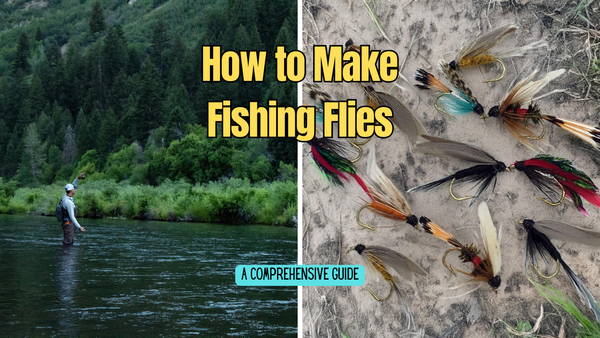The tippet might seem like a small and insignificant part of the fly fishing gear, but it is far from it. This thin, translucent strand of plastic is what makes the difference between a successful catch and a missed opportunity. Understanding the importance of the tippet, its materials, sizes, and how to use it effectively can significantly enhance your fly fishing experience.
Key Takeaways:
- A tippet is the final piece of the fly fishing setup that connects the fly to the leader.
- Tippets come in various materials, including nylon, fluorocarbon, and copolymer, each with unique properties.
- Understanding tippet sizes and strengths is crucial for successful fly fishing.

Introduction to Tippets in Fly Fishing
Fly fishing is an art that requires precision, patience, and the right equipment. Among the essential components of a fly fishing setup is the tippet. But what exactly is a tippet for fly fishing? In simple terms, the last 1.5- 2.5 feet typically consist of the tippet, which is the final section of the leader system. The leader transitions from the thicker fly line down to the thinner tippet, which directly connects to the fly. This transition is vital for smooth energy transfer during casting and for presenting the fly naturally.

The Role of the Fly Fishing Tippet
The tippet is the final piece that connects the fly to the leader. It is designed to be nearly invisible in the water, allowing the fly to move naturally and enticingly. This is crucial because fish are often wary of anything that looks unnatural. A well-chosen tippet can make your fly appear more lifelike, increasing your chances of a successful catch.
In addition to its invisibility, the tippet also needs to be strong enough to handle the fish's fight. This balance between invisibility and strength is what makes choosing the right tippet material and size so important. Whether you're fishing for small trout or larger species, the tippet plays a vital role in your overall fly fishing strategy.
Materials Used in Tippets
Tippets are made from various materials, each with its own set of advantages and disadvantages. The most common materials are nylon, fluorocarbon, and copolymer. Nylon tippets are known for their flexibility and ease of use. They are also relatively inexpensive, making them a popular choice for beginners.
Fluorocarbon tippets, on the other hand, are more durable and have a higher strength-to-diameter ratio. They are also less visible in the water, making them ideal for clear water conditions. Copolymer tippets offer a balance between the two, providing good strength and flexibility. Understanding these materials can help you choose the right tippet for your specific fly fishing needs.
Sizes and Strengths
Tippets come in various sizes, usually indicated by an "X" rating. The "X" rating refers to the diameter of the tippet, with smaller numbers indicating thicker tippets. For example, a 3X tippet is thicker and stronger than a 6X tippet. The choice of tippet size depends on the type of fish you're targeting and the conditions of the water.
The strength of the tippet is also crucial. A tippet that is too weak will break easily, while one that is too strong may be too visible to the fish. Finding the right balance between size and strength is key to successful fly fishing. It's also important to consider the type of fly you're using, as different flies require different tippet sizes for optimal performance.
How to Choose the Right Tippet
Choosing the right tippet involves considering several factors, including the type of fish you're targeting, the water conditions, and the type of fly you're using. For example, if you're fishing in clear water, a fluorocarbon tippet may be the best choice due to its low visibility. On the other hand, if you're fishing in murky water, a nylon tippet may be sufficient.
It's also important to consider the size of the fish. Larger fish require stronger tippets, while smaller fish can be caught with thinner tippets. Additionally, the type of fly you're using can influence your choice of tippet. Dry flies, for example, often require thinner tippets to float properly, while wet flies and streamers may need thicker tippets for better control.
Spools and Organization
Tippet spools are an essential part of any fly fisher's gear. These spools contain the tippet material and are usually labeled with the size and material type. Keeping your tippet spools organized can save you time and frustration on the water. Many fly fishers use tippet holders or dispensers to keep their spools easily accessible and tangle-free.
Proper organization also involves knowing when to replace your tippet. Over time, tippet material can degrade, especially if exposed to sunlight or harsh conditions. Regularly checking your tippet for signs of wear and tear can prevent unexpected breaks and improve your overall fishing experience.
Knots and Tippet Connections
Connecting the tippet to the leader and the fly requires strong, reliable knots. The most commonly used knots for this purpose are the improved clinch knot and the double surgeon's knot. These knots are known for their strength and ease of tying, making them ideal for fly fishing.
Practicing these knots and ensuring they are tied correctly can make a significant difference in your fishing success. A poorly tied knot can easily break, leading to lost flies and missed opportunities. Taking the time to master these knots can pay off in the long run, making your fly fishing experience more enjoyable and productive.
Material: Nylon vs. Fluorocarbon vs. Copolymer
Nylon, fluorocarbon, and copolymer are the three main types of tippet materials, each with its own set of characteristics. Nylon tippets are flexible and easy to handle, making them a popular choice for beginners. They are also relatively inexpensive, which is an added advantage.
Fluorocarbon tippets are more durable and have a higher strength-to-diameter ratio. They are also less visible in the water, making them ideal for clear water conditions. Copolymer tippets offer a balance between the two, providing good strength and flexibility. Understanding the differences between these materials can help you make an informed decision when choosing a tippet.
The Importance of Tippet Diameter
The diameter of the tippet is a crucial factor in fly fishing. A thinner tippet is less visible to the fish, making it more effective in clear water conditions. However, thinner tippets are also weaker and more prone to breaking. On the other hand, thicker tippets are stronger but more visible, which can spook fish.
Finding the right balance between tippet diameter and strength is key to successful fly fishing. It's also important to consider the type of fly you're using, as different flies require different tippet diameters for optimal performance. For example, dry flies often require thinner tippets to float properly, while wet flies and streamers may need thicker tippets for better control.
Tippet Length and Its Impact
The length of the tippet can also impact your fly fishing success. A longer tippet allows for more natural fly movement, which can be crucial in clear water conditions where fish are more cautious. However, longer tippets can be more challenging to control, especially in windy conditions.
On the other hand, shorter tippets provide better control and are easier to cast, but they may not allow for as natural fly movement. Finding the right tippet length involves considering the water conditions, the type of fish you're targeting, and your casting skills. Experimenting with different lengths can help you find what works best for you.
Tippet Strength and Breaking Strength
The strength of the tippet is another crucial factor to consider. Tippet strength is usually measured in pounds and indicates how much force the tippet can withstand before breaking. Choosing a tippet with the right strength involves considering the size and strength of the fish you're targeting.
For example, if you're fishing for small trout, a tippet with a breaking strength of 2-4 pounds may be sufficient. However, if you're targeting larger fish, you'll need a tippet with a higher breaking strength. It's also important to consider the type of fly you're using, as different flies require different tippet strengths for optimal performance.
Tippet and Fly Line Compatibility
Ensuring that your tippet is compatible with your fly line is crucial for successful fly fishing. The tippet should be strong enough to handle the fish's fight but also flexible enough to allow for natural fly movement. This balance between strength and flexibility is what makes choosing the right tippet material and size so important.
It's also important to consider the type of fishing line you're using. Different fly lines have different characteristics, and choosing a tippet that complements your fly line can enhance your overall fishing experience. For example, if you're using a floating fly line, a nylon tippet may be the best choice due to its flexibility and ease of use.

Leader and Tippet Compatibility
The tippet and leader need to work together seamlessly for successful fly fishing. The fly fishing leader is the tapered section of the line that connects the fly line to the tippet. It gradually gets thinner towards the tippet, allowing for smooth energy transfer during casting. Ensuring that your tippet is compatible with your leader is crucial for optimal performance.
Choosing a tippet that matches the diameter of the leader's end can enhance your casting accuracy and fly presentation. It's also important to consider the type of leader you're using, as different leaders have different characteristics. For example, if you're using a tapered leader, a fluorocarbon tippet may be the best choice due to its low visibility and high strength.
If using a too thick diameter tippet compared to the leader, it can cause poor turnover and affect casting accuracy. Conversely, if the tippet is too thin compared to the leader, it might not transfer the energy efficiently, leading to a collapse of the cast. The tippet should be chosen to match the leader's diameter closely enough to maintain casting efficiency.
Fly Rod Compatibility
Ensuring that your tippet is compatible with your fly rod is crucial for successful fly fishing. The tippet should be strong enough to handle the fish's fight but also flexible enough to allow for natural fly movement. This balance between strength and flexibility is what makes choosing the right tippet material and size so important.
It's also important to consider the type of fly rod you're using. Different fly rods have different characteristics, and choosing a tippet that complements your fly rod can enhance your overall fishing experience. For example, if you're using a lightweight fly rod, a nylon tippet may be the best choice due to its flexibility and ease of use.
Fly Compatibility
Ensuring that your tippet is compatible with your fly is crucial for successful fly fishing. The tippet should be strong enough to handle the fish's fight but also flexible enough to allow for natural fly movement. This balance between strength and flexibility is what makes choosing the right tippet material and size so important.
It's also important to consider the type of fly you're using. Different flies have different characteristics, and choosing a tippet that complements your fly can enhance your overall fishing experience. For example, if you're using a dry fly, a thinner tippet may be the best choice due to its ability to float properly. When fishing streamers, the tippet helps in presenting the fly naturally. A longer tippet can enable the streamer to move more freely in the water, mimicking the action of a baitfish or other prey.
Water Conditions
The water conditions can significantly impact your choice of tippet. In clear water conditions, a fluorocarbon tippet may be the best choice due to its low visibility. On the other hand, in murky water conditions, a nylon tippet may be sufficient. Understanding the water conditions can help you choose the right tippet for your specific fly fishing needs.
It's also important to consider the type of fish you're targeting. Different fish species have different behaviors and preferences, and choosing a tippet that matches these characteristics can enhance your overall fishing experience. For example, if you're targeting trout in clear water, a fluorocarbon tippet may be the best choice due to its low visibility and high strength.
Casting Techniques
Your casting technique can also impact your choice of tippet. A well-chosen tippet can enhance your casting accuracy and fly presentation, making your fly fishing experience more enjoyable and productive. It's important to consider the type of fly you're using, as different flies require different tippet sizes and strengths for optimal performance.
Practicing your casting technique and ensuring that your tippet is properly tied can make a significant difference in your fishing success. A poorly tied tippet can easily break, leading to lost flies and missed opportunities. Taking the time to master your casting technique and choosing the right tippet can pay off in the long run.
Fly Fishing Leaders
Fly fishing leaders are an essential part of any fly fisher's gear. The leader is the tapered section of the line that connects the fly line to the tippet. It gradually gets thinner towards the tippet, allowing for smooth energy transfer during casting. Ensuring that your tippet is compatible with your leader is crucial for optimal performance.
Choosing a tippet that matches the diameter of the leader's end can enhance your casting accuracy and fly presentation. It's also important to consider the type of leader you're using, as different leaders have different characteristics. For example, if you're using a tapered leader, a fluorocarbon tippet may be the best choice due to its low visibility and high strength.
Manufacturers
Fly fishing manufacturers play a crucial role in providing high-quality tippet materials and gear. Ensuring that your tippet is properly tied and compatible with your fly can enhance your fly fishing experience by making your fly appear more lifelike and natural in the water. This can make your fishing trips more enjoyable and productive.
It's also important to consider the reputation and quality of the fly fishing manufacturer when choosing tippet materials. High-quality tippet materials can provide better strength and durability, enhancing your overall fishing experience. Taking the time to research and choose reputable fly fishing manufacturers can pay off in the long run.
Fishing Shops
Fly fishing shops are a great resource for finding high-quality tippet materials and gear. Ensuring that your tippet is properly tied and compatible with your fly can enhance your fly fishing experience by making your fly appear more lifelike and natural in the water. This can make your fishing trips more enjoyable and productive.
It's also important to consider the reputation and quality of the fly fishing shop when choosing tippet materials. High-quality tippet materials can provide better strength and durability, enhancing your overall fishing experience. Taking the time to research and choose reputable fly fishing shops can pay off in the long run.
Fishing Guides
Fly fishing guides are a great resource for learning about tippet materials and techniques. Ensuring that your tippet is properly tied and compatible with your fly can enhance your fly fishing experience by making your fly appear more lifelike and natural in the water. This can make your fishing trips more enjoyable and productive.
It's also important to consider the reputation and experience of the fly fishing guide when seeking advice on tippet materials and techniques. Experienced guides can provide valuable insights and tips, enhancing your overall fishing experience. Taking the time to research and choose reputable fly fishing guides can pay off in the long run.

Summary
Understanding what a tippet is and its role in fly fishing is crucial for any angler. The tippet is the final piece that connects the fly to the leader, playing a vital role in ensuring the fly behaves naturally in the water. Choosing the right tippet material, size, and strength can significantly enhance your fly fishing experience. Whether you're a beginner or an experienced angler, taking the time to understand and properly use tippets can make a significant difference in your fishing success.

FAQs
What is the best material for a tippet?
The best material for a tippet depends on the water conditions and the type of fish you're targeting. Fluorocarbon is ideal for clear water due to its low visibility, while nylon is more flexible and easier to handle.
How do I choose the right tippet size?
Choosing the right tippet size involves considering the type of fish you're targeting and the type of fly you're using. Smaller fish and dry flies often require thinner tippets, while larger fish and streamers may need thicker tippets.
How often should I replace my tippet?
It's advisable to regularly check your tippet for signs of wear and tear and replace it as needed. Exposure to sunlight and harsh conditions can degrade the tippet material over time, so regular inspection and replacement can prevent unexpected breaks
Related articles:












